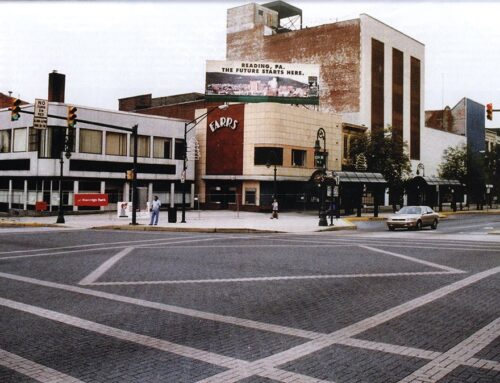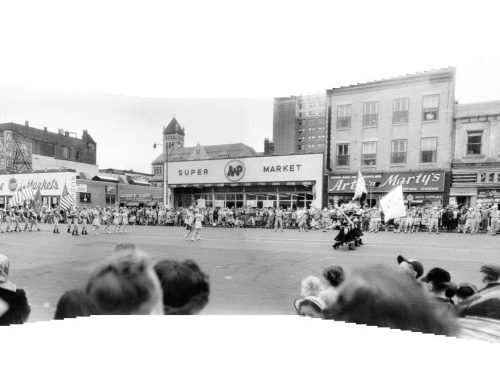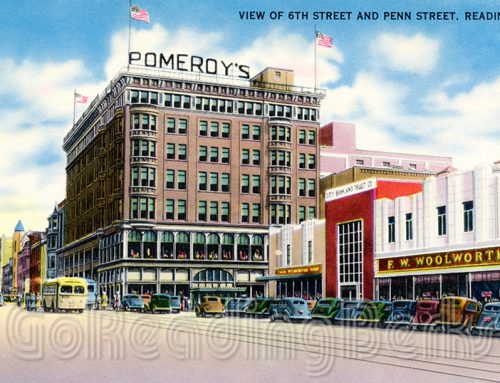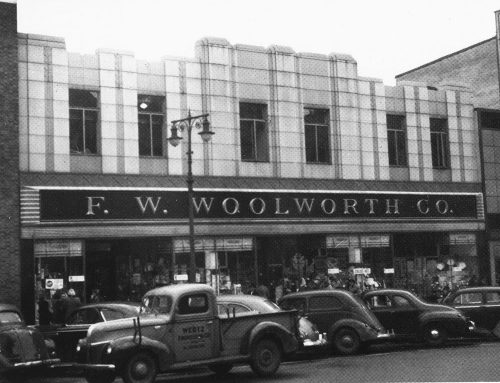Mr. Whitner was a son of the late George Whitner, and was born in Oley Township at Yellowhouse. He was educated in the township schools and worked on his father’s farm. Calvin K. Whitner began his career in Oley Township, Berks County, not far away from the place of his birth, when he entered the country store of Jacob S. Spang & Son at Spangsville, in 1861. He remained there as a clerk until 1865, when he went to Friedensburg with Edwin S. Bear, trading as Whitner & Bear, carried on a store for two years.
He came to Reading in 1868 and took a position as book-keeper with Kline, Eppihimer & Co, where he remained until 1877. In 1877, he started a dry goods store for himself at 432 Penn Square, with 6 employees.

Like the predecessors of many other Penn street establishments, Mr. Whitner’s first store was confined entirely to the first floor of a converted dwelling. It handled a line of dry goods and notions. All the selling space was on the first floor while a portion of the basement and second floor were used for receiving rooms and storage. The room available for selling space was typical of the first floor facilities of any large dwelling in those days. It contained less than 2,000 square feet in a room of about 20 by 90 feet.
A newspaper description gives the following account of store’s opening:
“Mr. Calvin K. Whitner will open today at 432 Penn street, a new dry goods store, with an entire new stock. Mr. Whitner is one of our most careful and energetic businessmen, and having had long experience, will be able to conduct his establishment on first-class principles. The opening today, it is expected, will be largely attended by the ladies of this city, to whom every facility will be extended for a thorough examination of the stock.”
As recorded in Whitner’s ledger, first-day sales total $159. Each day the volume grew and at the end of the first year he was able to report that his total sales had aggregated slightly less than $37,000.
It was only six years after the store was opened that the need for larger quarters was felt. So business and stocks were transferred in 1883 to the buildings at 442-444 Penn Street. The store building at 444 Penn Street had been vacated by Dives, Pomeroy & Stewart.
Mr. Whitner conducted the business by himself individually until 1889 when his son, Harry K. Whitner was taken into the firm. The firm traded as C. K. Whitner & Son until the son’s death in December, 1890.
More departments were added and in 1891 additional expansion was accomplished by extending back to Cherry Street. In 1896, a faithful employee for many years, John A. Britton, was admitted as a partner, and the firm name became C. K. Whitner & Co. One year later, in 1897, rooms at 438 and 440 Penn street were added and in 1899 more space toward Cherry Street was utilized. The department store continued to expand and, by 1910, a four-story main building stood on Penn Street, with a five-story structure in the rear on Cherry Street. At the completion of the expansion and modernization more than 60,000 square feet of floor space was available, including warerooms.

Then with owners and employees proud of their modernized home, came a blow. It was the spectacular fire of May 25, 1911. About 7 p.m. fire bells rang and spectators who rushed to Penn Square saw smoke billowing from the store. Firemen battled long and valiantly but in the end the founder and chief owner of the store saw 34 years of planning and hard work buried in a pile of charred timbers and fire-blackened walls.
Temporary quarters were secured for the office and other departments the next day and sometime later a store was opened in the old auditorium on South Fifth Street. Plans for a new building were started at once and on July 15th a contract was awarded to the Beard Construction Company. The plans provided for a five-story building on Penn street and three floors and a basement on Cherry Street.
The operation that followed represented the fastest, major building operation in Reading. The building was to be ready for occupancy on the first floor and basement within 60 working days. Holidays and rainy days were not to be considered and no Sunday work was permitted.
On October 14, on Mr. Whitner’s 70th birthday anniversary, a new five-story building on Penn Street, with a three-story-and-basement structure on Cherry Street was opened for the-first time. With the new building completed more than 90,000 square feet of selling and storage space were available.

On July 29, 1941 a permit was issued for new annex at 428-436 Penn Street at a cost of $125,000. Just 75 days after work began Whitner’s new annex on Penn Street was opened to the public. A feature of the new building was its handsome, 18-foot-high display windows.
More additions, and modernization, to the Penn Street store were to continue in the passing years. Extensive changes were to include air-conditioning, Reading’s first set of escalators on Aug. 21, 1948, a $250,000 annex on the northwest corner of Fifth and Cherry streets in August 1956, and extensive interior and exterior renovations including the creation of a single Penn Street entrance and new brick-and-marble facing in 1967.

In early December 1980 citing declining customer traffic in downtown Reading, John Whitner Rick, chairman of the board and great-grandson of the founder, announced that the store would close in early.
In June 1981 Whitner’s closed ending 104 years as a downtown retailer.
In 1982 Whitner’s heirs sold the building to a company owned by Musa J. Eways, who operated it as Reading Downtown Mall. The mall never caught on, and by 1987, the building was boarded up.
In September 1987 Joseph M. Eways proposed the construction of a 20-plus-story ultramodern skyscraper called “The Reading Renaissance Center” at the former site of C. K. Whitner Co. Inc. Department Store. The structure was designed by New York City architect Der Scutt. Scutt, a Reading native, was instrumental in the concept of the architecturally innovative Trump Tower in Manhattan. Later plans for the Renaissance Center called for a 38-story building housing a hotel, offices, and retail space.
In 1989 City Council denied Joseph Eways request to demolish the former Whitner Department store based on its location in the Callowhill Historical District and for lack of information from the developer to approve the demolition.
In December 1990, developer Joseph M. Eways announced that he was shelving plans for a $55-million downtown skyscraper, because of what he claimed was the city’s lack of cooperation and tightening finances. Former Mayor Warren H. Haggerty Jr. countered that the city tried to work with Eways but that no sufficient evidence was provided to indicate the Renaissance building would be constructed.
In 2004 the C. K. Whitner Co. Inc. department store was demolished to make way for the Sovereign Plaza.





Leave A Comment